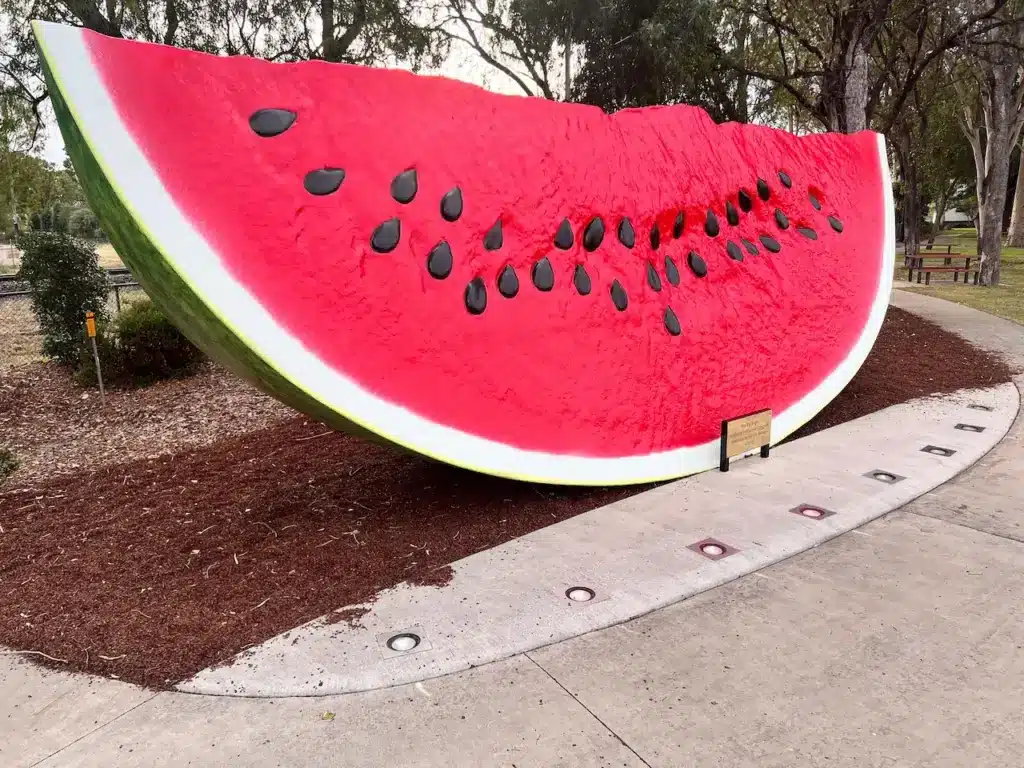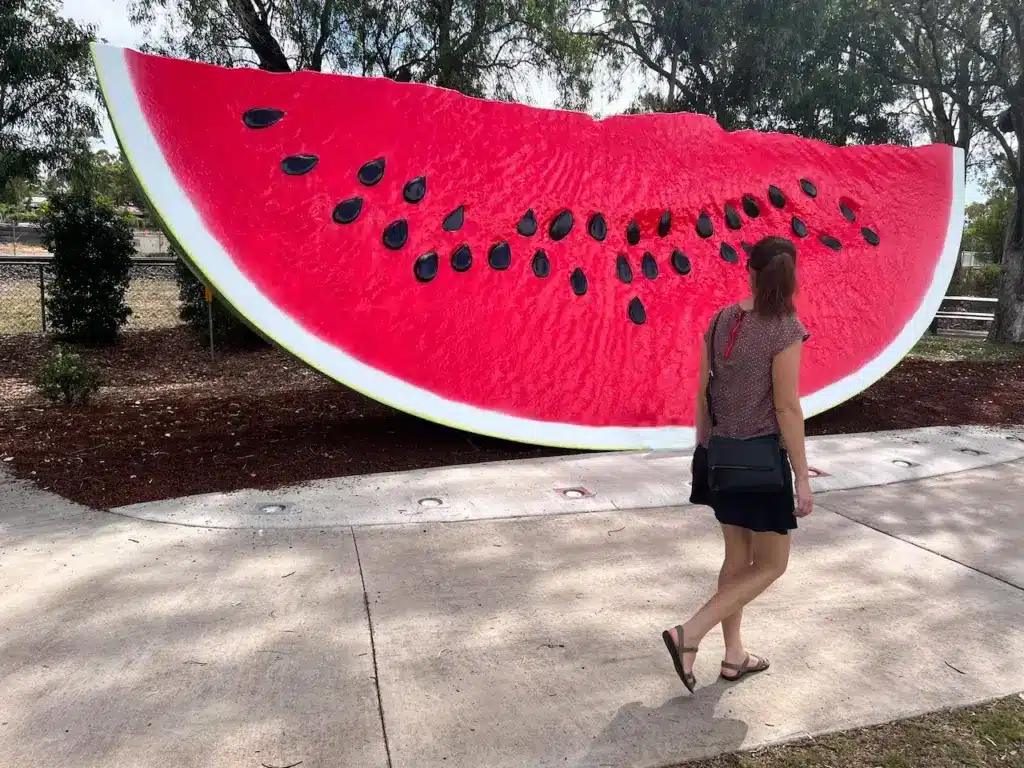The Big Melon: You Need To Know Everything About
Introduction
On your walk into Chinchilla, prepare to pause and snap a picture of this enormous piece of bright pink watermelon. This famous watermelon slice, four tonnes in weight, three meters in height, and nine meters in width, is prominently displayed on the Warrego Highway between the railway crossing and the Chinchilla Visitor Information Center.
Table of Contents
ToggleAustralia’s wide and varied geography, peppered with famous sites like Uluru and the Sydney Opera House, is home to the Big Melon, a singular representation of rural history. Though it may not be as well-known abroad as its more prominent brethren, the Big Melon is still important in Australian history and culture.
This article explores this enormous fruit sculpture’s history, importance, and effects, charting its transformation from a popular local attraction to a treasured part of Australia’s cultural heritage.

History and Origin
The idea of creating large sculptures, or “big things,” became fashionable in Australia in the 1960s and 1970s. These buildings functioned as oddball markers of the local identity in addition to being tourist attractions. The Australian rural community of Chinchilla came up with the concept for the Big Melon after being influenced by this trend.
The “melon capital” of Australia, Chinchilla, is well-known for its booming melon business, which specializes in rock and watermelons. The idea of building a massive melon came to mind to honor the town’s agricultural past and attract tourists.
This dream became a reality in 1990 with the formal unveiling of the Big Melon, which now stands tall as a symbol of Chinchilla’s agricultural achievements.
Planning and Building
The Big Melon is a sight, standing about 7 meters tall and weighing many tons. The artwork, made of steel and fibreglass, has extraordinary attention to detail in replicating a ripe watermelon’s unique feel and shape. Amidst the rural terrain, it stands out as a stunning landmark because of its lifelike aspect and brilliant hues.
The Big Melon was built with the help of local engineers, artists, and community people. Every process step, from conception to completion, was carefully designed to guarantee the sculpture’s robustness and aesthetic appeal.
The project was driven ahead by the enthusiasm and devotion of everyone involved, despite budgetary limits and logistical problems, resulting in the construction of a treasured cultural landmark.
Importance And Cultural Effects
Beyond being aesthetically pleasing, the Big Melon is important to Chinchilla locals and tourists. It is a reminder of the town’s rich farming history and the tenacity of rural communities, symbolizing agricultural pride. Furthermore, the Big Melon is essential to increasing tourists and stimulating the local economy.
Thousands of visitors visit Chinchilla yearly to see the famous sculpture and participate in the lively melon festival. The yearly celebration honours everything melon-related and includes events like seed-spitting competitions, melon tastings, and the coronation of the “Melon Queen.”
As a result of these celebrations, the Big Melon has come to represent friendship and community spirit, creating a feeling of oneness among locals and tourists.
Moreover, the large Melon has become well-known outside Chinchilla and is now regarded as one of Australia’s most recognizable “big things.” Its increasing popularity has been attributed to its placement in travel guides and lists of roadside attractions, drawing curious tourists nationwide.
Obstacles And Conservation Initiatives
Despite its ongoing popularity, the Big Melon has had difficulties, such as natural wear and tear and maintenance problems. Due to aging infrastructure, vandalism, and exposure to the elements, periodic maintenance operations have been necessary to maintain the sculpture’s survival.
Community-led projects and fundraising efforts have been started to help the protection of the Big Melon in response to these difficulties. Businesses, government entities, and volunteers in the area have worked together to carry out maintenance projects and make the required repairs.
These initiatives highlight the enduring bond that the people of Chinchilla have with their valued monument, enhancing its standing as a treasured cultural symbol.
The Big Melon’s Location
The Big Melon is located in Queensland’s Western Country Area, along Warrego Highway, adjacent to the Chinchilla Information Center.
Undoubtedly, the Big Melon immediately became popular in Chinchilla and throughout Australia. It makes sense that most of Australia’s Big Things, particularly the oldest ones, appear a little older, but the Big Melon of Chinchilla appears deliciously young. It is three meters high, nine meters long (26 feet), and weighs at least four tons. It is made of fibreglass.
There’s more to Chinchilla than simply the Big Melon. Here’s a brief overview of some of the enjoyable activities in this region of Queensland.

Facilities
Deck of Observation
Reach the summit of The Big Melon for sweeping views of the surrounding landscape. It’s the perfect location for taking breath-inspiring pictures or admiring the Australian countryside’s splendour.
Shops of Gifts
Peruse an assortment of keepsakes, regional handicrafts, and souvenirs to remember your time at The Big Melon.
Picnic Area
Surrounded by beautiful vegetation and plenty of seats, families and parties may have a leisurely picnic in the designated area near The Big Melon.
Cafe
The on-site cafe serves light meals, snacks, and freshly made coffee. Come here to unwind.
Integrated Exhibits
Engaging exhibitions and displays that shed light on The Big Melon’s construction and cultural importance can teach you about its history and significance.
Coach Parking
Feasibility of coach park is available.
Car Park
A big car park is available.
Fun Activities In Chinchilla
The ideal location to establish a connection with the town’s history is the Chinchilla Historical Museum. You can discover more about the people and their culture at the museum.
This town is also the location of the Chinchilla Botanic Parkland and the Charleys Creek Walk if you enjoy spending time outside connecting with nature. Specifically, the Chinchilla Weir offers power sites, picnic spaces with barbecues, and camping amenities for up to two nights.
The Barakula State Forest, Lapunya Art Gallery, Richard Best Memorial Park, Cypress Pine Art Sculpture, and Cactoblastis Monument are a few other noteworthy locations in the town.
Without a doubt, Chinchilla has become more globally known because of the Big Melon. Its advantageous position, right off the Warrego Highway, facilitates finding it more easily. For instance, the Melon Festival drew a minimum of 15,000 attendees in 2019. Recall that this occurred within a year following the Big Melon’s formal introduction.
Based on these figures, it is reasonable to assume that the attendance record will continue to improve over the next few years. The greatest time to see this now-famous building is now, and the second-best time is right now if you haven’t already.
Final Thoughts
In conclusion, the Big Melon represents the essence of a town firmly rooted in its agricultural heritage and is much more than just a massive sculpture of a fruit. The Big Melon has had a lasting impact on Australia’s cultural environment, having evolved from a small local effort to a national emblem of rural pride.
Through a common appreciation of history, inventiveness, and the timeless beauty of gigantic fruit, the Big Melon continues to unite people as tourists marvel at its towering presence and residents celebrate its past.




